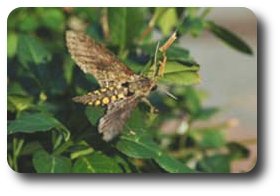The hawk moth uses plant odors to locate plants like tomatoes to serve as food for her young.
Over the past few weeks several bug aficionados have sent images or specimens of two of the most prodigious eating machines on the planet – the tomato and tobacco hornworms, so named for the curious horn at the tip of their rear ends. These leaf-munching dynamos may gain more than one thousand times their weight from the time the minute larva hatches from an egg until the four inch long caterpillar transforms into a pupa. This remarkable change is equivalent to an eight-pound baby growing into an eight thousand pound man. No wonder your tomato plants disappear before your very eyes! In addition to tomatoes, these hornworms feed on other members of the nightshade family including tobacco and occasionally eggplant, pepper, and potato.
These hornworm caterpillars have all but devoured this tomato plant.
How did the hornworm arrive on your tomato in the first place? It was deposited as a tiny egg on the undersurface of a leaf by a hawk moth a few weeks before you found it. The beautiful hawk moth is grayish-brown with rows of yellow spots lining its abdomen. It flies at night and is an important pollinator of several native and introduced plants especially ones with tubular flowers such as honeysuckle, phlox, petunia, and tobacco. From these plants the hawk moth obtains energy rich nectar. After the female lays her eggs, they hatch in a few days. The caterpillar will have five or six larval stages and its development takes about three weeks. The pale green color of the caterpillar enables it to blend with foliage and probably helps prevent detection by birds and other predators looking for a tasty meal. Often the caterpillar droppings, called frass, or leaf damage are the first clues of a hornworm attack.
This unlucky hornworm bears dozens of cocoons of small parasitic wasps that developed within its body.
After completing its larval development, the hornworm moves to the soil to change into a pupa. Early in the season moths will emerge from many of the pupae and the life cycle will repeat. But as autumn grows near, pupae will suspend their development and spend the winter hidden in the soil or leaf litter. When the warmth of spring returns and the presence of food plants is assured, pupae will complete their development and hawk moths will emerge to feed, mate, and lay eggs. Unfortunately for the hornworm, the world is a dangerous place. In addition to predators such as birds and assassin bugs, like the wheel bug we met in the August 1 installment of bug of the week, small, parasitic wasps attack and kill hornworms.
After completing development, the wasps pop the top of their cocoons and emerge to seek other victims.
A curious gardener brought in a hornworm covered with scores of “white thingies.” These “thingies” are often confused with parasite eggs but they are actually the cocoons of tiny wasps spun by wasp larva after they emerged from inside the hornworm. After completing the transition from larva to pupa to adult, wasps emerge from the cocoons and fly off to find other caterpillars. The female wasp stings the caterpillar and inserts many eggs. Eggs hatch into legless larvae that feed on the caterpillar's blood and cause its demise. If you see hornworms or other caterpillars in your garden flocked with white or yellow cocoons, leave them alone. Let the parasites emerge and assist you in the battle against these plant-eating machines.
References:
To learn more about hornworms and hawk moths visit the following web sites:
http://creatures.ifas.ufl.edu/field/hornworm.htm
http://www.colostate.edu/Depts/CoopExt/4DMG/Pests/tomato.htm
http://www.amonline.net.au/factsheets/hawk_moths.htm



